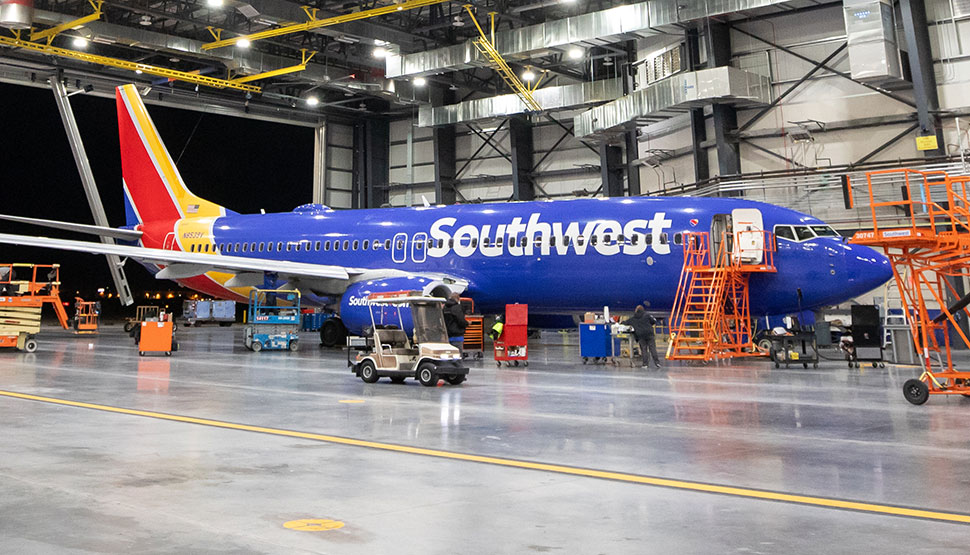Taking risk quality to new heights
Publish Date : 17 June 2024

It's hard to hide a 130,000-square-foot building.
But for most Southwest Airlines passengers, the massive maintenance hangars are rarely noticed – tucked far away from the boarding gates, security lines and rental car counters at major airports around the United States.
These buildings on the outskirts of the airport, the ones you only see from the shuttle bus or from the super economy parking lot, are more important than anyone realizes.
"Southwest's hangar facilities are absolutely critical to our operations," explained Ed Jonak, Southwest Airlines plant and maintenance manager. "The FAA has strict maintenance requirements, and we must focus on the proper and timely maintenance of our fleet to avoid delays or cancellations."
While passengers may miss the significance of these buildings, their importance is not lost on those at Southwest. They are a vital component of the Southwest operation that delivers nearly 130 million passengers to their destinations every year. Throughout the organization, Southwest is laser focused on keeping these facilities running smoothly.
"It takes the entire organization, not just risk management," said Carlos Lopez, senior manager of corporate insurance. "From the vice president of facilities to the facility maintenance technicians across our network, we have universal buy-in to do what it takes to keep our facilities resilient."
Importance eclipsed by size
The importance of these facilities is eclipsed only by their colossal size. These massive complexes can fit three 737s inside and include offices, warehouse space and maintenance shops. They house specialized equipment needed to maintain and, in some locations, disassemble and reconstruct a 737 aircraft.
These facilities also feature complex fire suppression systems, thousands of square feet of roof and huge hangar doors. The complexity of the facilities raises potential hazards for Southwest to manage, and that's why it enlisted FM as its insurance carrier seven years ago.
"If it's important to FM it is important to Southwest Airlines," Lopez added. "We work together to stay prepared and avoid a loss."
Building to HPR standards
Southwest's commitment to mitigating risk is most prominently displayed at its new facilities. Working with FM, before ground is even broken, Southwest sets out to construct highly protected risk (HPR) facilities. The airline's newest facility in Denver, an expansion in Phoenix and new construction underway in Baltimore are all aiming for the HPR designation.
"Plan review was the first way we were brought into the HPR world," said Tyler McBride, Southwest's insurance & claims consultant.
"The services FM offers give us a different way to think about things, ensuring that we are securing the best project resources possible."
The complexity of the facilities makes it difficult to retrofit existing buildings to meet HPR requirements, which is why Southwest is committed to building to HPR standards from the start of a project.
"Maintenance hangars are where Southwest can impact risk quality the most," said Sarah Nordman, FM senior account manager. "Since day one, we've focused on protecting the airline from a business interruption, one of their biggest risks."
Knowledge sharing
The relationship with FM has provided Southwest new insights into lowering the risks it faces—everything from determining how much ignitable liquid should be kept on site, to preparing for a hurricane, to adhering to local fire-protection regulations.
"FM is a huge resource for me and my staff," Jonak added. "If I have a question about anything, it usually takes one phone call to FM, and I have an answer within a few hours. FM's risk assessment knowledge is top-notch."
Changing regulations
That knowledge has been particularly helpful in the ever-changing world of aircraft fire protection. Most aircraft fire suppression systems rely on foam instead of water, but changing regulations are pushing the entire industry to more environmentally friendly foam alternatives.
"There are significant fire protection needs at the maintenance hangars because of the ignitable liquid, industrial fuels and airplane jet fuel," said Sarah Gloyeske, FM account engineer. "We're doing in-depth research to understand the alternative types of foam that can be used to meet new environmental standards and still protect the facility and aircraft."
Whatever the eventual answer, Southwest is confident it will have the very best scientifically based protection available. Similar to the risk mitigation solutions for all other potential hazards the airline faces.
"Our facility folks regularly tout that our footprint has improved because of our relationship with FM," Lopez concluded. "The FM engineering standards have elevated Southwest's standards."
